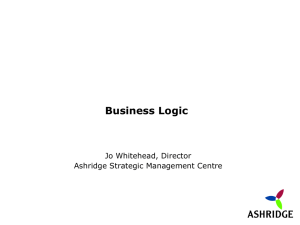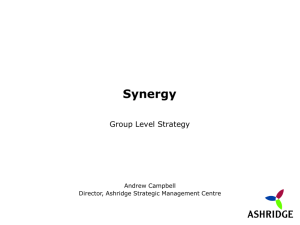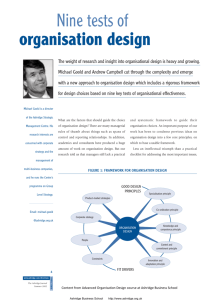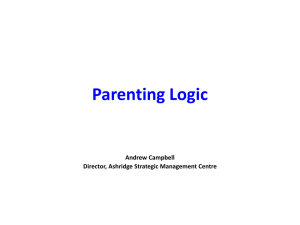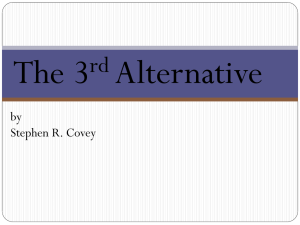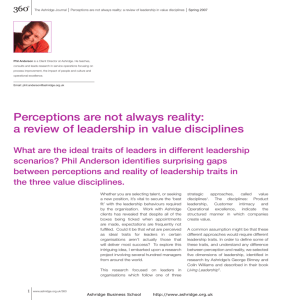Why in-house collaboration is so difficult
advertisement
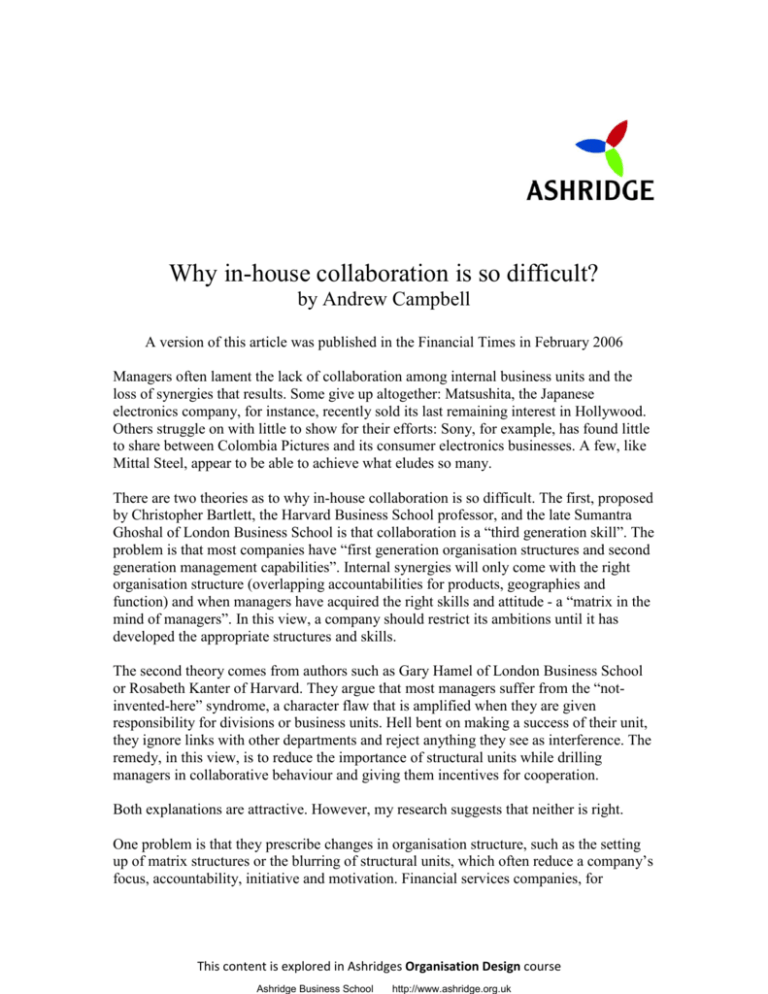
Why in-house collaboration is so difficult? by Andrew Campbell A version of this article was published in the Financial Times in February 2006 Managers often lament the lack of collaboration among internal business units and the loss of synergies that results. Some give up altogether: Matsushita, the Japanese electronics company, for instance, recently sold its last remaining interest in Hollywood. Others struggle on with little to show for their efforts: Sony, for example, has found little to share between Colombia Pictures and its consumer electronics businesses. A few, like Mittal Steel, appear to be able to achieve what eludes so many. There are two theories as to why in-house collaboration is so difficult. The first, proposed by Christopher Bartlett, the Harvard Business School professor, and the late Sumantra Ghoshal of London Business School is that collaboration is a “third generation skill”. The problem is that most companies have “first generation organisation structures and second generation management capabilities”. Internal synergies will only come with the right organisation structure (overlapping accountabilities for products, geographies and function) and when managers have acquired the right skills and attitude - a “matrix in the mind of managers”. In this view, a company should restrict its ambitions until it has developed the appropriate structures and skills. The second theory comes from authors such as Gary Hamel of London Business School or Rosabeth Kanter of Harvard. They argue that most managers suffer from the “notinvented-here” syndrome, a character flaw that is amplified when they are given responsibility for divisions or business units. Hell bent on making a success of their unit, they ignore links with other departments and reject anything they see as interference. The remedy, in this view, is to reduce the importance of structural units while drilling managers in collaborative behaviour and giving them incentives for cooperation. Both explanations are attractive. However, my research suggests that neither is right. One problem is that they prescribe changes in organisation structure, such as the setting up of matrix structures or the blurring of structural units, which often reduce a company’s focus, accountability, initiative and motivation. Financial services companies, for This content is explored in Ashridges Organisation Design course Ashridge Business School http://www.ashridge.org.uk instance, often strive to create a “one-stop experience” for customers, but instead merely sow confusion and poor service. A second difficulty is that big investments are required before synergy benefits can be demonstrated. Managers need to be trained to work in matrix structures. New managers may need to be brought in to replace those with insufficient skills or intractable, “notinvented-here” attitudes. Structural changes need to be bedded in. If it turns out that the synergy benefits are limited, much of the investment has been wasted. In one company, we calculated that the group-wide, marketing coordination was costing more than $60,000 a meeting. The company had spent over $600,000 on these meetings with little tangible benefit. A third problem involves “contamination”. Different business units often need to operate by different rules and cultural norms. An up market perfume business needs to focus on leading fashion and should be staffed by those who can do this. A low priced perfume business needs to focus on costs and be led by people with different values. Organisational boundaries help keep them at a distance. The effort to create synergies can blur these boundaries allowing contaminating influences to seep across. In one company, attempts to find purchasing synergies between white goods retailers in two countries prompted one management team to adopt the other team’s higher-priced products. The experiment was a disaster. Customers left because they became confused about the product positioning, and the products had to be sold at a loss. The most important problem, however, is the presumption each theory makes about why collaboration is difficult. Our research suggests that there are a wide range of reasons depending on the situation. In some cases, collaboration does not happen because the presumed synergies are a mirage. Managers at the coal face cannot see any benefits in working across boundaries. Senior executives, meanwhile, search for synergies to give more meaning to their jobs and their group of businesses. Like thirsty travellers in the desert, their desire clouds their vision. In other cases, the opportunity costs are too great. Synergies do exist, but potential collaborators have more important priorities. Distracting them from their more important tasks results in a loss of value greater than that gained from the collaboration. In still other cases, there are operating skill issues (when no manager has sufficient expertise to judge which unit has best practice), chemistry issues (when bad past experiences have poisoned relationships) or systems issues (when the IT system cannot provide the data needed for collaboration). This range of reasons suggests a different approach to collaboration difficulties. First, managers should put more effort into calculating the size of the prize. This is not a question of broad concepts like best practices or savings on group purchases. It needs to be a cost-benefit analysis of a tightly defined synergy opportunity. Ashridge Business School http://www.ashridge.org.uk If the synergy is about standardisation of sales training for example, the assessment would need to include the following: on the benefits side would be the incremental sales from better training in some units and the reduced cost of developing materials in the future; on the cost side would be the management time it would take to agree, the cost of the materials, the cost of retraining the trainers, the loss of sales from delayed training in some units and some assessment of the opportunity cost to other priorities. Inevitably the calculation is a rough one. But, unless the benefits are a multiple of the costs, the collaboration is probably not worth the effort. Second, once the prize is clear, managers can investigate why collaboration is not already happening. In relationships with third parties - joint ventures, outsourcing arrangements and alliances - we observe some of the most sophisticated and thoughtful collaborative arrangements. In other words, managers are quite capable of setting up sophisticated collaborative relationships when they want to. Hence it is necessary to go beyond broad concepts such as not-invented-here attitudes to understand why sensible managers are not doing what appears to be the sensible thing. Typically, there are precise reasons connected with relationships, competing priorities, resource constraints, insufficient skills of a particular kind or other operational issues. Third, once the reason for inaction is clear, managers can assess whether they have the skill and will to unblock the problem. Sometimes it requires hard choices in terms of restructuring or personnel changes, sometimes hands-on expertise on the part of managers. The fourth discipline is to look out for downsides – distraction costs, contamination risks, loss of accountability, initiative and motivation. There is a dark side to collaboration that is all too apparent in some organisations. In these organisations, it is politically correct to collaborate regardless of the cost to the organisation. By applying these four steps, senior managers can create synergies without the up-front investment implied by the current received wisdom, and without the risks associated with blurred accountability and restructured organisations. Companies such as Mittal Steel - focused globally on one product area - are likely to have more opportunity for synergy than businesses, like Sony, which try to span industries. Nevertheless, the most successful practitioners of collaboration are those who take a thoughtful, cautious, analytical approach. Those who instead create blurred matrix structures and use training, incentives and a one-firm campaign to appeal to the “better nature” of their managers, are most likely to end up frustrated. Andrew Campbell is a director of the Ashridge Strategic Management Centre. The Centre has recently developed a training module on internal collaboration. Further reading Ashridge Business School http://www.ashridge.org.uk M. Goold and A. Campbell, Desperately Seeking Synergy, Harvard Business Review, Sept-Oct 1998 D. Sull and C. Spinoza, Using Commitments to Manage Across Units, Sloan Management Review, Fall 2005 E. Anderson and S. Jap, The Dark Side of Close Relationships, Sloan Management Review, Spring 2005 How to make collaboration work? • • • • Confirm that the benefits are significantly larger than the likely costs and make sure those concerned understand the cost-benefit analysis. Give them a chance to challenge the analysis. Understand why those concerned are not already collaborating: identify the blockages. Make sure you can see the issue through their eyes. Figure out whether you can remove the blockages. Do you have the will? Do you have the skill? Do you have the time or resources? Check that your planned action is not going to have major downsides in terms of loss of accountability, loss of motivation or distraction costs. Ashridge Business School http://www.ashridge.org.uk


